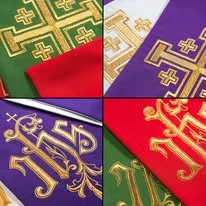Liturgical vestments are an inseparable part of every Eucharistic celebration in the Catholic Church. They are not only practical elements but also have a deep symbolic meaning—they emphasize the holiness of the liturgy and express the spiritual role of the priest as the leader of the community. Each vestment has a specific purpose and significance, and its proper selection is regulated by Church law. It is important to understand which elements of the vestment are essential during the celebration of the Holy Mass and why they hold such great importance.
The Alb – A Sign of Purity and Priestly Dignity
The alb is the fundamental liturgical vestment worn by priests, deacons, and other ministers assisting in the Holy Mass. It is a long, white garment reaching the ankles, typically made from light fabric, symbolizing purity of heart and the dignity of the priesthood. Its color recalls the white garment received by the newly baptized, signifying new life in Christ. In practice, the alb covers the celebrant’s everyday clothing, serving as a reminder that his role in the liturgy transcends daily concerns.
To ensure the proper fit of the alb, a cingulum (belt or cord) is tied around the waist. While not always mandatory, this element symbolizes readiness for service and spiritual discipline. Before liturgical reforms, the alb was often accompanied by a humeral, a linen cloth placed over the shoulders, which had both a practical function (protecting against sweat) and a spiritual meaning, representing a shield against temptation.
The Stole – A Sign of Priestly Authority
One of the most significant elements of a priest’s vestment during the celebration of the Holy Mass is the stole. It is a long, narrow strip of fabric worn around the neck, with its ends either hanging straight down or crossed over the chest and secured to the alb. The stole symbolizes the authority of the priesthood and the mission entrusted to the clergy to administer sacraments and guide the faithful community.
Deacons also wear a stole, but in a different manner—draped diagonally over the left shoulder, with one end hanging to the side and the other fastened at the waist. This distinctive way of wearing the stole represents the servant role of the deacon and differentiates him from the priest. The color of the stole always corresponds to the liturgical season or feast, further emphasizing the significance of the celebration.
The Chasuble – The Vestment of the Eucharistic Celebrant
The most recognizable element of a priest’s vestment during Holy Mass is the chasuble. It is an outer garment worn over the alb and stole, often richly decorated, and its cut varies depending on liturgical tradition. The chasuble symbolizes the love and sacrifice of Christ, as well as the priest’s unity with Christ, who gave His life for the salvation of humanity.
The color of the chasuble changes according to the liturgical season:
- Green is worn on Sundays during Ordinary Time.
- Violet is used during Advent and Lent.
- White or gold is worn during the most important celebrations such as Christmas and Easter.
- Red is used on the feasts of martyrs and the Holy Spirit.
- Rose is worn only twice a year—on the Third Sunday of Advent and the Fourth Sunday of Lent, symbolizing joy within penitential seasons.
The Vestments of the Deacon and Other Liturgical Elements
The deacon, who assists the priest in the Holy Mass, wears a dalmatic—a vestment with wide sleeves, often richly decorated, symbolizing his service and unity with the Church community. Like the chasuble, the dalmatic changes color according to the liturgical season and is worn over the alb and stole.
In some cases, during solemn celebrations, additional liturgical elements may be worn, such as the maniple—a narrow strip of fabric draped over the priest’s forearm, which historically symbolized the burdens of priestly service. Though no longer required after liturgical reforms, the maniple remains significant in traditional Latin Mass celebrations.
The Meaning and Spiritual Significance of Liturgical Vestments
Each element of the liturgical vestment carries a profound spiritual and symbolic meaning. They not only emphasize the importance of the sacred rituals but also help the priest and the faithful focus on worshiping God. In the Catholic Church, liturgical vestments are not merely symbols of clerical office but expressions of unity with tradition and Christ’s mission.
The Holy Mass is not simply a gathering of the faithful but a true Eucharistic sacrifice, in which Christ is made present. Therefore, it is essential for the priest to wear the proper vestments, not only in accordance with liturgical regulations but also with an awareness of their spiritual significance. Their appropriate use reminds the faithful of the holiness of the Eucharist and enhances their participation in the liturgy, revealing its beauty and depth.





